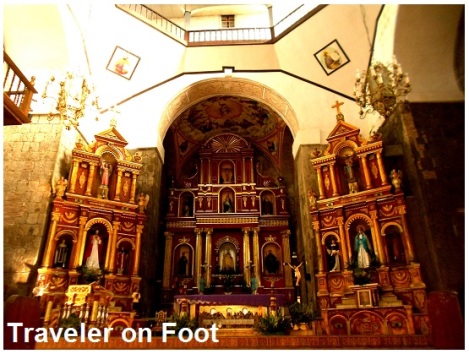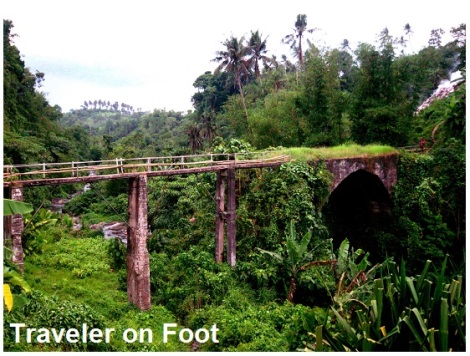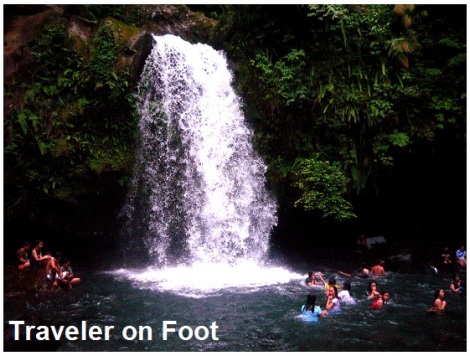
UNFAMILIAR MAJAYJAY. With the monsoon season beginning to wash away the last traces of summer, Majayjay is not the usual destination for a curious traveler who loves the sun. Located at the foothills of mystical Mount Banahaw, a sacred ground for soothsayers, amulet makers, faith healers and seekers of the divine, the road to Majayjay appears to be shaded from the glares of sunlight.
I have come to an unfamiliar Majayjay one Saturday morning to locate at what the stories from writers Anita Feleo and David Sheniak described as an 18th century bridge called Puente de Capricho and a cable car ride across a 600-feet wide chasm at the Botocan Gorge.


THE ROAD TO MAJAYJAY IS HIGH. In the olden days, Majayjay can be reached from Manila through boats that ferry passengers from the Pasig River across Laguna de Bay, then switched on horseback to the foothills of Mount Banahaw. Since then, this mountain town had a reputation among early travelers for being far and secluded that they sigh catching their breaths ‘hay… hay.. Majayjay!’
The journey to Majayjay today is less complicated. Passed by the narrow roads of Nagcarlan and Liliw then upon crossing the centuries-old bridge spanning the ethereal Olla River, Majayjay is just a few minutes away. Beneath the ancient bridge are children bathing and women doing their laundry, while seated midstream on the rocks surrounded by gurgling spring water. An empty grotto is situated near the riverbank which probably where the larger-than-life statue of the Nuestra Señora de Porteria used to stand. The statue is located in another grotto at ground level, a few meters above the original. From the Virgin’s grotto, the road climbs up sloppy hills, twisting and turning, until it reaches the town of Majayjay.


MAJAYJAY GUESTBOOK. By the 17th century, Majayjay was already famous for its massive church and cool climate making it a popular destination among travelers, Spanish officials and European royalties. During the American period, then US Governor to the Philippines William Howard Taft was so captivated by Majayjay that he ordered a road constructed from the town to Botocan Falls.
Visitors in those days stayed in the church convent or in fine stone houses along the main street and around the plaza. The elegant ancestral houses are still present to this day but they seldom open their doors to strangers.


REPOSITORY OF FOLK MEMORY. A major landmark in Majayjay is the Church of San Gregorio Magno. First stone church was built three times. The construction from 1606 to 1660 resulted to thick walls that sandwiched the original wall with new coating of bricks and mortar on both sides. But more than being an important specimen of colonial architecture, the church has become a repository of folk memory.
According to local history, Franciscan friars forced the natives to construct the massive church. When a fire burned down the first church, the native went on a mass exodus beyond the town boundaries to avoid being listed again for building duties but the friars chased locals and forced them back to town.


CHURCH ARTIFACTS. Inside the ancient church are antique images of saints, relleves and paintings on wood and ecclesiastical paraphernalia. It is said that what we see today are the few remaining church treasures of a once magnificent display of church artifacts.
In 1988, it was rumored that a parish priest was selling antique church silver and wood reliefs carved by local artists to fund his projects. The townspeople reacted by bringing the case to court. As I stepped out of the church, I asked myself where all those wonderful things now are.

PUENTE DE CAPRICHO. Locating a bridge called Puente de Capricho became a challenge. Feleo and Sheniak described the bridge as a huge unfinished stone bridge jutting out of Olla River. However, most of the locals cannot identify which among several stone bridges of Majayjay I was referring to, until I met an old local at a convenient store who described a bridge of which both ends were blown up during the filming of a foreign movie in the 1970s. He recalled that the ends of this bridge were of wood and not a part of the original stone bridge. This bridge is not a popular route, however is popularly known among the locals as tulay pigi. The bridge can be accessed after passing by a dumpsite then going down a steep incline.
Puente de Capricho was a project of Fray Victorino de Moral. The bridge was meant to be a short cut to the town. The bridge earned its name as Puente de Capricho or bridge of whims perhaps due the bridge-building duties forced by the friar to the locals. It is said that those who refused to participate in bridge building were beaten with a whip on the buttocks, which explains why some locals popularly call Puente de Capricho as tulay pigi or buttock bridge. The bridge appeared in film like Tatlong Taong Walang Dios and Apocalyse Now.


TAYTAY FALLS. For some required government formalities, the cable car ride at the Botocan Gorge did not go as I wanted. Since the site is owned by the National Power Corporation, it required official permit from the mayor to access the facility. Rather than going through all the hassles, I found myself heading to Taytay Falls instead.
Taytay Falls is located in a valley on the southern foot of Mount Banahaw. The trip consists of a 20 minute drive from the town then another 20 minute hike to the falls. The falls empty into a deep, cold pool surrounded by the forested mountain walls. While it cost practically nothing to enjoy the ice-cold water of Taytay Falls but to go for a swim means bringing along friends and family in my next visit. I went back to Majayjay town proper.

SECRETS OF THE ERMITA. While waiting for the next jeepney that will take me back to Nagcarlan, I walked towards the old ermita. Originally constructed as the tribunal during the Spanish period, it was converted into a chapel for the image of the Nuestra Señora de Porteria. This image of the Blessed Mother was brought by the Franciscans to the country and was placed in the receiving room of every Franciscan house. In this room, the hungry and the poor are given food and alms and the sick awaited their turn for treatment in the infirmary. Weary travelers could spend the night in porteria.
EPILOGUE. Fitting to the legend, it is said that the chapel has a secret tunnel with two laterals, one leading to the Majayjay Church, the other to Mount Banahaw. The legend predicts that when the waters surrounding Laguna rises and floods the area, only Mount Banahaw will be saved. Since the people Majayjay have access to the tunnel, they will survive the deluge.
-Feast of Sta. Rita de Cascia 2008
Wish your blogs are compiled in a book form for easy access anytime.Would make for a beautiful coffee table book.
Thank you Julie. Someday I will. Glenn
ei! have you re-visited majayjay since then? botocan? intead to explre more this coming election weekend
let me know
there are a lot to discover about majayjay, just like the infamous trivial political history and land ownership.
Wow! This is an old town of mine. I was born and raise in Majayjay. I can’t help but to reminisce all my happy memories when I was a kid.
Almost every week, I escorted my mother to Olla River to do our laundry. While she’s busy washing clothes I was busy as well but swimming (not helping her) in the deep river with fellow kids and having a great time. One time a leech leaked my left leg to suck blood. Yuck! I felt it because my leg got so itchy so I rubbed it with laundry bar soap. The leech repelled.
I climbed lanzones tree in our backyard for its fruits. It’s still green but I don’t care. I ate it anyway.
My grandfather worked in his farm every single day. He always brought us anything from when he come home. He brought guavas, tubo ng niyog, and I remember, TAGBAK. It is hard to explain what kind of fruit is it. The only thing I can remember is, when I opened the shell, there were times tiny flies came out flying out from the tiny seeds inside. Whoa! It has a sweet taste and probably nutritious. I don’t know if it is still available.
I climbed in the church tower as far as where the huge bells are. How scenic! You see the beautiful Laguna de Bay on you right and Mt. Banahaw on the left. What an unforgetable moment!
The delicious biko or sinukma of Na Emilia Lagui, the minukmuk of Na Sipa San Jose, the pandesal of Ma Tomas Trovela’s formulas were never passed into the next generation of their heirs. It could be a big profitable industry of Majayjay like the puto siko of Lucban. Too bad!
wow irene. the leads you stated here gave us more reasons to revisit enchanting Majayjay.
this is a memorable place for me and my hubby, we’re always looking forward to come back with our kids
my mom told me that she and my dad travelled a long way just to hear mass in majayjay when she was pregnant with me. the road conditon isn’t that good back then..she made a promise to visit the church more often granting San Gregorio will guide her during her giving birth=) 20 years later my dad filled all the church’s candelabras with candles as an offering for me to pass the board exam.it’s granted. after 2 years my husband did the same thing as he was asking for my safe pregnancy,again it’s granted. i did the same last 2007 as an offering again for another board exam..granted.=)
i asked a local hermana there to give me the size of the statue of San Gregorio because He was so good to me i decided to give him a new “dress”.. the gold terno he often wears came from my family=)
very inspiring story minella. I always want to go back to majayjay.
The centuries-old bridge that spanned the Olla river is now destroyed due to typhoon “Santi”
A steel bridge will be constructed in its place.
Oh my! I hope there will be efforts to restore the structure.
I envy you. You’ve been to Majayjay when Olla Bridge was still “alive”. When I went there a few months ago, a new Olla Bridge was already in place. 😦
It was one of those unprepared trips Pepe. I went there after reading the book by Anita Feleo- Cabinet of Wonders.
I fell in love with Majayjay the first time I went to the place Jessiedel.
I will go back to visit Botocan. I just need to find a reliable contact to help me access the place since it is under NAPOCOR.
I suggest that you go to the municipio and coordinate with the tourism office.
wow this is my province thanks for putting our place in the net…